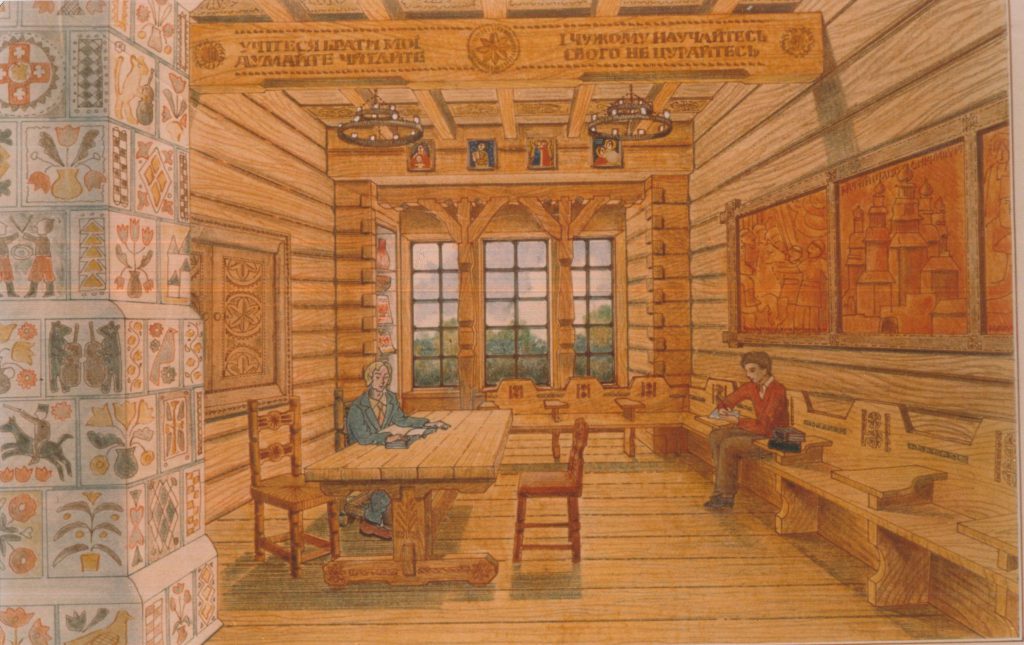By Emily Wolfe
October 2020

Like the rest of the University of Pittsburgh’s 31 Nationality Rooms, the Ukrainian room on the third floor of the university’s Cathedral of Learning is part active classroom and part museum. The room, one of the smaller nationality rooms, is largely modeled after a 17th-century svitlytsia, a living room where a Ukrainian nobleman would receive his guests. The svitlytsia emphasizes hospitality and faith, key concepts in Ukrainian culture; signage inside the room cites an Eastern European proverb: “When a guest enters the home, God enters the home.”
Construction began on the Ukrainian room in 1988, a date meant to mark a millennium of Christianity in Ukraine—measured from 988, the year the ancestors of modern-day Ukrainians, Belarusians, and Russians converted from paganism to Christianity on the order of the Kievan ruler Vladimir. The doorway of the room bears Vladimir’s tryzub, a trident-like cross symbol that also serves as modern-day Ukraine’s coat of arms. Other religious iconography in the room includes a set of portraits above the pokutia (place of honor), four replicas of traditional Renaissance and Byzantine artistic depictions of Christian icons: Saint Nicholas, the “Wonder-Worker”; the Hodegetria, a portrayal of Mary with the child Jesus; the Pantocrator, a representation of Christ the Teacher holding an open book; and Saint George. The doors to the wooden chalkboard on one wall of the room depict a carved tree of life.

“Ukrainian Room,” Nationality Rooms at University of Pittsburgh YouTube channel. Still showing the icons of (left to right) Saint Nicholas, the Hodegetria, Christ the Teacher, and Saint George. 
“Ukrainian Room Sketch,” University Archives, University of Pittsburgh Library System. An artist’s sketch from the design stage of the Ukrainian room.
Pittsburgh’s own Ukrainian Christian community emerged in the late 19th century, when early Ukrainian immigrants began building Orthodox and Catholic churches for Ukrainian worshippers. Two of Pittsburgh’s largest Ukrainian houses of worship, St. John the Baptist Ukrainian Catholic Church and St. Vladimir’s Ukrainian Orthodox Church, still sit just ten blocks apart in the South Side, where most early Ukrainian immigrants settled.
Although Pittsburgh had amassed a significant Ukrainian population by the early 20th century, Ukraine was not represented in the initial cluster of nationality rooms constructed at Pitt in the 1930s and 1940s. The Ukrainian community’s first request to sponsor a nationality room was rejected in 1937 by the university, which held that rooms could only be built for nations recognized by the United States State Department. A Ukrainian Nationality Room Committee was eventually created in 1975, and began working to raise funds for a nationality room—more than $250,000 over the next 15 years.
The Ukrainian room was dedicated in June of 1990, a little over a year before Ukraine declared independence from the Soviet Union. At the room’s dedication celebration, two prominent Ukrainian-American religious leaders—an Orthodox archbishop and a Catholic bishop—co-led a ceremony to bless the classroom and sanctify the icons.
Featured Image
“The Ukrainian Room,” Wikimedia Commons. View on entering the door of the Ukrainian room.
Further Reading
“Nationality Rooms.” University of Pittsburgh. https://www.nationalityrooms.pitt.edu/. Accessed 17 Oct. 2020.
“Ukrainians in Pittsburgh.” Popular Pittsburgh. https://popularpittsburgh.com/ukrainians-pittsburgh/. Accessed 17 Oct. 2020.
How to Cite
MLA: Wolfe, Emily. “Ukrainian Nationality Room.” ReligYinz: Mapping Religious Pittsburgh. University of Pittsburgh, 8 Jan. 2021, religyinz.pitt.edu/ukrainian-nationality-room/
APA: Wolfe, E. (2021, January 8). Ukrainian nationality room. ReligYinz: Mapping Religious Pittsburgh, University of Pittsburgh. https://religyinz.pitt.edu/ukrainian-nationality-room/
Chicago: Wolfe, Emily. “Ukrainian Nationality Room.” ReligYinz: Mapping Religious Pittsburgh. University of Pittsburgh, January 8, 2021. https://religyinz.pitt.edu/ukrainian-nationality-room/

3 Comments
Comments are closed.